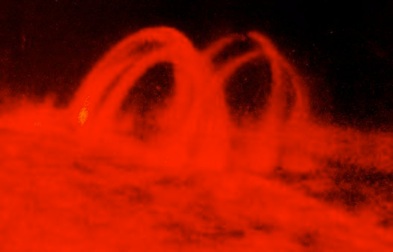Jason Scott’s Research Interests

Solar Coronal Loops:
The solar corona is HOT (millions of degrees K) and how it is heated is unknown.
A significant part of the energy emission in the solar corona is found along isolated strands or loops that follow curved paths. The plasma in these loops is thought to trace out magnetic field lines. These loops are the fundamental elements of the solar corona. Loops are involved in most if not all coronal activity. They are key to understanding the basic processes of the solar corona.

Coronal Loops Imaged with Skylab
I participated in the MSU summer Research Experience for Undergraduates (REU) program for the summer of '02. In particular we studied the temperature structure of coronal loops. The REU program is a valuable opportunity for any undergraduate. For more information on what we did please check out my short lecture here.
I was an advisor for two students in the Summer 2011 REU program here is a presentation.
I observe solar coronal loops and solar active regions with multiple instruments. Specifically these instruments are high resolution imagers like (Transition Region and Coronal Explorer (TRACE) and Atmospheric Imaging Assembly (AIA) and imaging spectrometers such as Coronal Diagnostic Spectrometer (CDS) and Extreme ultraviolet Imaging Spectrometer (EIS). The high resolution and fast time cadence images allow for temporal investigation of morphology and brightness. The spectral information tells us what the plasma properties (temperature, density, doppler velocity, non-thermal width) are from analysis of the spectral line profiles.
More about research I am involved with:
Publications
Scott, J.T.; Martens, P.C.H.; On the Anti-correlation between Spectral Line Broadening and Intensity in Coronal Structures Observed with EIS , 2011, ApJ, 742, 101
Scott, J.T.; Martens, P.C.H.; McKenzie,D.E.; EUV Analysis of a Quasi-static Coronal Loop Structure, 2012 Solar Physics, 276, 113-131
Scott, J.T.; Cirtain, J.W.; Martens, P.C.H.; Analysis of two Coronal Loops with Combined TRACE and SoHO/CDS Data, 2008, Solar Physics, 252, 293
Schmelz, J.T., Scott, J., Rightmire, L.A.; May Day! Coronal Loop Temperature from the Hinode EUV Imaging Spectrometer, 2008,Apj, 684, L115
Longcope, D.W.; Cirtain, J.W.; McKenzie, D.; Scott, J.; Observations of Separator Reconnection to an Emerging Active Region, 2005, Apj, 630, 596